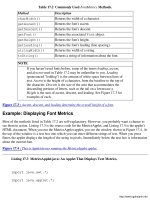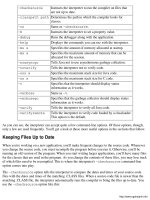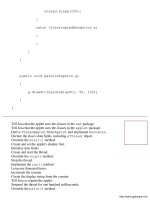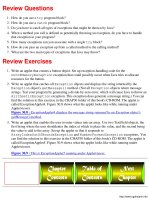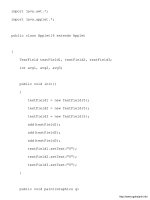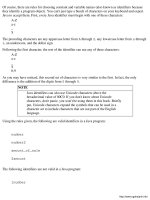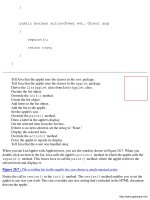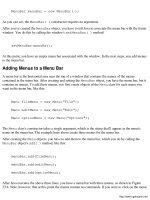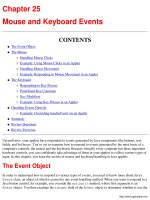Java By Example PHẦN 4 pdf
Bạn đang xem bản rút gọn của tài liệu. Xem và tải ngay bản đầy đủ của tài liệu tại đây (1.9 MB, 59 trang )
Figure 12.1 : This is the Applet13 applet running under Appletviewer.
Listing 12.1 Applet13.java: Printing Instructions in an Applet.
import java.awt.*;
import java.applet.*;
public class Applet13 extends Applet
{
public void paint(Graphics g)
{
g.drawString("Try to guess the number I am", 48, 65);
g.drawString("thinking of. The number will be", 48, 80);
g.drawString("between 0 and 100. You have an", 48, 95);
g.drawString("unlimited number of tries.", 48, 110);
g.drawString("Good Luck.", 95, 140);
}
}
Applet13 is about the simplest applet you can write. All it does is display text. The text comprises
instructions for playing a simple number game. If you had to sum up in a couple of words the task
performed by Applet13's paint() method, you might come up with something like "Draw
Instructions," which is an excellent name for a function to handle that task. Listing 12.2 is a new version
of the applet that isolates the instruction-display task in its own function. When you run this applet, it
looks identical to Applet13.
Listing 12.2 Applet14.java: Placing the Instructions in a Function.
import java.awt.*;
import java.applet.*;
public class Applet14 extends Applet
{
public void paint(Graphics g)
{
DrawInstructions(g);
}
void DrawInstructions(Graphics g)
{
g.drawString("Try to guess the number I am", 48, 65);
g.drawString("thinking of. The number will be", 48, 80);
g.drawString("between 0 and 100. You have an", 48, 95);
g.drawString("unlimited number of tries.", 48, 110);
g.drawString("Good Luck.", 95, 140);
}
}
Now for the million-dollar question: How does this Applet14 work? The program is divided into two
functions. The first is the paint() method, which Java calls whenever the applet's display area must be
redrawn. In this applet, paint() is at the highest level of your top-down design. That is, no other part
of the program calls paint(), but paint() calls functions that are lower in level.
NOTE
You might be confused about the difference between methods,
functions, and subroutines. The truth is that they are very similar.
Specifically, a method is a function that is part of a class. So, in
Applet14, both paint() and DrawInstructions() are
methods of the Applet14 class. (They are also functions.) A
subroutine is a function that returns no value. That is, it has the
word void in front of its name.
The second function in Listing 12.2 is the DrawInstructions() subroutine, which is really just a
Java function that returns no value to the calling function (paint(), in this case).
DrawInstructions() is one level down from the main program in the top-down design. In
paint(), instead of having all the code that's needed to display the instructions, you only have a line
that calls the function that handles this task. This makes it easier to see what's going on in paint(). If
you need to see more detail, you can always drop down a level in your program and take a look at
DrawInstructions().
Defining and Calling Functions
There are two things you must do to use a function in a program. The first thing you must do is define the
function, which means that you must write all the program instructions that make up the function, placing
the instructions between curly braces. You must also determine what arguments the function must have
in order to perform its task. In Applet14, the DrawInstructions() function definition looks like
Listing 12.3.
Listing 12.3 LST12_3.TXT: The DrawInstructions( ) Subroutine.
void DrawInstructions(Graphics g)
{
g.drawString("Try to guess the number I am", 48, 65);
g.drawString("thinking of. The number will be", 48, 80);
g.drawString("between 0 and 100. You have an", 48, 95);
g.drawString("unlimited number of tries.", 48, 110);
g.drawString("Good Luck.", 95, 140);
}
The first line of Listing 12.3 tells Java the type of value returned from the function, the name of the
function, and the arguments that must be sent to the function when it's called. In this case, the type of
return value is void, which means the function returns no value. The name of the function is
DrawInstructions, and its argument is a Graphics object called g. (Notice that, in the function's
first line, you must list both the argument type and argument name.) If you look at the paint()
method, you can see that Applet14 calls the DrawInstructions() function like this:
DrawInstructions(g);
This line tells Java that you want to execute the program code in the DrawInstructions() function
and that you want to pass the Graphics object g to the function. DrawInstructions() needs
access to g because it is the Graphics object that has the drawString() method. Without access to
the Graphics object, DrawInstructions() cannot perform its task in the same way that the
drawString() method cannot display a string unless you give it the string and the location at which
to display the string.
The second thing you must do to use a function is to call the function. When you call a function, program
execution jumps to the commands that make up the function. All commands in the function are executed,
after which the program returns to the line after the function call.
NOTE
The arguments you place between the parentheses of a function call
must be of the same type and in the same order as the arguments
given in the function's first line. That is, the call
DrawInstructions(g) and the first line of the function,
DrawInstructions(Graphics g), match perfectly because
the function call sends a Graphics object and the function
expects a Graphics object. The names of the arguments,
however, don't have to match. For example, the function call
DrawInstructions(g) and the function name
DrawInstructions(Graphics graph) are still a match.
The only difference is that you'd have to refer to graph inside the
DrawInstructions() function, rather than to g.
Example: Using Functions to Return Values
In Java, functions are the main way you can break up your programs into modules. But unlike when you
used functions as subroutines, some types of functions return a value to the main program. You've used
this type of Java function before in this book. The String class' valueOf() method is one. The value
it returns is the numerical value of a string containing digits.
You can assign a function's return value to a variable. Suppose you have a function named GetNum()
that calculates a number and returns it to your program. A call to the function might look something like
this:
int num = GetNum();
The function might look something like Listing 12.4.
Listing 12.4 LST12_4.TXT: An Example of a Function.
int GetNum()
{
++value;
return value;
}
Listing 12.4 shows some of the differences between using functions as subroutines (which return no
value) and using functions to return values. While functions being used as subroutines always start with
the keyword void, functions that return values start with the keyword int, char, float or whatever
type of return value you need. Also, since subroutines return no value, they need no return statement.
But as you can see, the GetNum() function returns a value by using the return keyword along with
the value to be returned. If you fail to include the return command in the body of a function that
returns a value, Java's compiler will give you an error message.
NOTE
Normally, arguments passed into a function are passed by value,
which means that a copy of the passed value is given to the
function. When you change the value of the argument in the
function, you are changing the copy, while the original value stays
the same. However, some arguments are passed by reference, which
means that the original object is passed to the function. In this case,
changing the argument's value in the function changes the original
value, too. You learn about passing by reference in
Chapter 13,
"Arrays."
Example: Putting Functions to Work
Think you understand functions now? The applet you'll build in this example will put your knowledge to
the test. Listing 12.5 is the applet's source code, whereas Listing 12.6 is the HTML document that'll load
and run the applet. Figure 12.2 shows what the applet looks like when it's running under Appletviewer.
Figure 12.2 : This is the Applet15 applet running under Appletviewer.
Listing 12.5 APPLET15.JAVA: Using Functions in a Java Applet.
import java.awt.*;
import java.applet.*;
import java.lang.Math;
public class Applet15 extends Applet
{
///////////////////////////////////////
// Data fields.
///////////////////////////////////////
TextField textField1;
int guesses;
int number;
////////////////////////////////////////
// Overridden methods.
////////////////////////////////////////
public void init()
{
textField1 = new TextField(10);
add(textField1);
textField1.setText("50");
guesses = 0;
number = CreateNumber();
}
public void paint(Graphics g)
{
DrawInstructions(g);
int guess = GetGuess();
ShowMessage(g, guess);
}
public boolean action(Event event, Object arg)
{
++guesses;
repaint();
return true;
}
////////////////////////////////////////
// Private methods.
////////////////////////////////////////
void DrawInstructions(Graphics g)
{
g.drawString("Try to guess the number I am", 48, 65);
g.drawString("thinking of. The number will be", 48, 80);
g.drawString("between 0 and 100. You have an", 48, 95);
g.drawString("unlimited number of tries.", 48, 110);
g.drawString("Good Luck.", 95, 140);
}
int GetGuess()
{
String s = textField1.getText();
int num = Integer.parseInt(s);
return num;
}
int CreateNumber()
{
float n = (float)Math.random();
number = (int)(n * 100 + 1);
return number;
}
void ShowMessage(Graphics g, int guess)
{
String s = "Guesses so far: ";
s += String.valueOf(guesses);
g.drawString(s, 80, 170);
if (guess < number)
g.drawString("Your guess is too low.", 70, 185);
else if (guess > number)
g.drawString("Your guess is too high.", 70, 185);
else
g.drawString("You guessed the number!", 65, 185);
}
}
Tell Java that the program uses classes in the awt package.
Tell Java that the program uses classes in the applet package.
Tell Java that the program uses the lang package's Math class.
Derive the Applet15 class from Java's Applet class.
Declare the class's data fields.
Override the Applet class's init() method.
Create the TextField object.
Add the TextField object to the applet.
Initialize the text in the TextField object to "50."
Initialize the guess counter to zero.
Create the number that the player must guess.
Override the Applet class's paint() method.
Print the game's instructions.
Get the player's guess.
Show the appropriate message based on the guess.
Override the Applet class's action() method.
Increment the guess counter.
Tell Java to redraw the applet's display area.
Tell Java that the action() method finished successfully.
Define the private DrawInstructions() method.
Display the game instructions in the applet.
Define the private GetGuess() method.
Get the text from the TextField object.
Convert the text to an integer.
Return the integer to the calling function.
Define the private CreateNumber() method.
Calculate a random number from 0 to 1.
Convert the random number to an integer between 1 and 100.
Return the random number to the calling function.
Define the private ShowMessage() method.
Display the number of guesses so far.
Display the results of the player's latest guess.
Listing 12.6 APPLET15.htmL: Applet15's HTML Document.
<title>Applet Test Page</title>
<h1>Applet Test Page</h1>
<applet
code="Applet15.class"
width=250
height=250
name="Applet15">
</applet>
When you run Applet15, the program selects a random numeral from 1 to 100. Your task is to guess the
numeral in the least number of tries. You type your guesses into the box at the top of the applet. When
the program starts, this box contains the number 50, and the hint at the bottom of the screen tells you
whether the number is high or low. Each time you enter a new number, the hint tells you whether the
guess is high or low.
Yes, it's true that Applet15 is much larger than the example applets you've used so far in this book, but
the program needs to be long in order to accommodate several different functions. By analyzing the
program's flow, you can determine whether or not you understand how functions work.
Start with the paint() method. By examining the function calls it contains, you can get a good idea of
what the program does. Specifically, the program displays the game's instructions, gets a guess from the
user, and then displays a message to the user. If you were only interested in examining the paint()
method, you wouldn't have to go any further; the details of how these other functions work are tucked out
of your way.
If you wanted to see exactly how the program prints the game's instructions, however, you could find the
DrawInstructions() method in the source code. The same is true for the other functions called in
the paint() method.
You can see that some of the functions return values and others don't. Similarly, some functions require
arguments and others don't. How the function is constructed depends on whether it must calculate and
return a value to the program (such as in CreateNumber()) and whether the function requires values
from the program in order to perform its task (such as ShowMessage(), which needs the Graphics
object and the player's latest guess).
There are probably several lines of Java source code in Listing 12.5 that don't make sense to you right
now. The pseudocode section following the listing describes, in general, what the program is doing.
You'll learn about many of the details in other chapters. At this point, you only need to worry about being
able to follow the function calls.
Summary
Functions enable you to break complicated programs down into easy-to-handle chunks. Moreover, by
using a top-down structure, your programs can organize code with functions that start off being general
in nature but get more detailed as you work your way deeper into the hierarchy. When a function doesn't
return a value (has a return type of void), it is used as a subroutine, which simply performs some task
before program execution jumps back to the line after the line that called the function. A function with a
return type other than void enables your programs to calculate a value and return the value to the calling
function. Either type of function can have one or more arguments, which enable the program to pass
values into the function.
Review Questions
1. What is top-down programming?
2. How do functions make top-down programming possible?
3. Do all functions return values?
4. What are arguments and how are they used?
5. What is meant by "defining a function"?
6. How do you return a value from a function?
7. How do the arguments given in a function call relate to the arguments accepted by the function?
8. How do you determine how to break a program up into functions?
Review Exercises
1. Write a function that prints a two-line message to the user.
2. Write a function that returns the number 1 as an integer.
3. Write a function that accepts two integer arguments and returns the sum of the arguments.
4. Modify the function from exercise 3 so that it sums the two arguments, calls yet another function
that multiplies the two arguments, sums the product and the original sum, and returns the result.
Write the function that performs the multiplication.
5. Modify Applet15 by adding a function that starts the game over each time the user guesses the
number. That is, after the user guesses the number, the program should select a new random
number and continue the game. Name the program GuessApplet.java. (You can find the
solution to this programming problem in the CHAP12 folder of this book's CD-ROM.)
Chapter 13
Arrays
CONTENTS
● An Introduction to Arrays
❍ Example: Creating an Array
❍ Example: Using a Variable as a Subscript
● Multidimensional Arrays
❍ Example: Creating a Two-Dimensional Array
● Example: Using Two-Dimensional Arrays in an Applet
● Summary
● Review Questions
● Review Exercises
As you've learned by now, using variables makes your programs flexible. Thanks to variables, you can
conveniently store data in your programs and retrieve it by name. You can also get input from your
program's user. The best thing about variables is that they can constantly change value. (They're called
variables, after all, because they're variable.)
Until now, you've learned about various types of numerical variables, including integers, long integers,
floating-point, and double floating-point variables. You also know about string variables, which can hold
text. Now that you have a good understanding of these data types, it's time to explore one last data type-a
handy data structure called an array.
An Introduction to Arrays
Often in your programs, you'll want to store many values that are related in some way. Suppose you
manage a bowling league, and you want to keep track of each player's average. One way to do this is to
give each player a variable in your program, as shown in Listing 13.1. Figure 13.1 shows the applet
running under Appletviewer.
Figure 13.1 : This is Applet16 running under Appletviewer.
Listing 13.1 Applet16.java: Using Variables to Track Scores.
import java.awt.*;
import java.applet.*;
public class Applet16 extends Applet
{
TextField textField1, textField2, textField3;
int avg1, avg2, avg3;
public void init()
{
textField1 = new TextField(5);
textField2 = new TextField(5);
textField3 = new TextField(5);
add(textField1);
add(textField2);
add(textField3);
textField1.setText("0");
textField2.setText("0");
textField3.setText("0");
}
public void paint(Graphics g)
{
g.drawString("Your bowlers' averages are: ", 50, 80);
String s = textField1.getText();
g.drawString(s, 75, 110);
avg1 = Integer.parseInt(s);
s = textField2.getText();
g.drawString(s, 75, 125);
avg2 = Integer.parseInt(s);
s = textField3.getText();
g.drawString(s, 75, 140);
avg3 = Integer.parseInt(s);
}
public boolean action(Event event, Object arg)
{
repaint();
return true;
}
}
When you run Applet16, you can enter bowling scores into the three boxes at the top of the applet's
display area. After you enter these averages, they're displayed on-screen as well as copied into the three
variables avg1, avg2, and avg3.
Nothing too tricky going on here, right?
Now examine the listing. Remember in
Chapter 10, "The while and do-while Loops," when you
learned to keep an eye out for repetitive program code? How about all those calls to getText(),
drawString(), and valueOf() in Listing 13.1? The only real difference between them is the
specific bowler's score that's being manipulated. If you could find some way to make a loop out of this
code, you could shorten the program significantly. How about a for loop that counts from 1 to 3?
But how can you use a loop when you're stuck with three different variables? The answer is an array. An
array is a variable that can hold more than one value. When you first studied variables, you learned that a
variable is like a box in memory that holds a single value. Now, if you take a bunch of these boxes and
put them together, what do you have? You have an array. For example, to store the bowling averages for
your three bowlers, you'd need an array that can hold three values. You could call this array avg. You
can even create an array for a set of objects like the TextField objects Applet16 uses to get bowling
scores from the user. You could call this array textField.
Now you have an array called avg that can hold three bowling averages and an array called
textField that can hold three TextField objects. But how can you retrieve each individual average
or object from the array? You do this by adding something called a subscript to the array's name. A
subscript (also called an index) is a number that identifies the element of an array in which a value is
stored. For example, to refer to the first average in your avg array, you'd write avg[0]. The subscript is
the number in square brackets. In this case, you're referring to the first average in the array (array
subscripts always start from zero.) To refer to the second average, you'd write avg[1]. The third average
is avg[2].
If you're a little confused, look at Figure 13.2, which shows how the avg[] array might look in
memory. In this case, the three bowling averages are 145, 192, and 160. The value of avg[0] is 145,
the value of avg[1] is 192, and the value of avg[2] is 160.
Figure 13.2 : An array can hold many values of the same type.
Example: Creating an Array
Suppose that you need an array that can hold 30 floating-point numbers. First, you'd declare the array
like this:
float numbers[];
Another way to declare the array is to move the square brackets to after the data type, like this:
float[] numbers;
After declaring the array, you need to create it in memory. Java lets you create arrays only using the new
operator, like this:
numbers = new float[30];
The last step is to initialize the array, a task that you might perform using a for loop:
for (int x=0; x<30; ++x)
numbers[x] = (float)x;
These lines of Java source code initialize the numbers[] array to the numbers 0.0 to 29.0. Notice how
the loop only goes up to 29. This is because, although there are 30 elements in the numbers[] array,
those elements are indexed starting with 0, rather than 1. That is, the subscript is always one less than the
number of the element you're accessing. The first element has a subscript of 0, the second a subscript of
1, the third a subscript of 2, and so on.
Example: Using a Variable as a Subscript
As you learned in a previous chapter, most numerical literals in a Java program can be replaced by
numerical variables. Suppose you were to use the variable x as the subscript for the array avg[]. Then
(based on the averages in Figure 13.2) if the value of x is 1, the value of avg[x] is 192. If the value of x
is 3, the value of avg[x] is 160.
Now take one last, gigantic, intuitive leap (c'mon, you can do it) and think about using your subscript
variable x as both the control variable in a for loop and the subscript for the avg[] and textField
arrays. If you use a for loop that counts from 0 to 2, you can handle all three averages with much less
code than in the original program. Listing 13.2 shows how this is done.
Listing 13.2 Applet17.java: Using Arrays.
import java.awt.*;
import java.applet.*;
public class Applet17 extends Applet
{
TextField textField[];
int avg[];
public void init()
{
textField = new TextField[3];
avg = new int[3];
for (int x=0; x<3; ++x)
{
textField[x] = new TextField(5);
add(textField[x]);
textField[x].setText("0");
}
}
public void paint(Graphics g)
{
g.drawString("Your bowlers' averages are: ", 50, 80);
for (int x=0; x<3; ++x)
{
String s = textField[x].getText();
g.drawString(s, 75, 110 + x*15);
avg[x] = Integer.parseInt(s);
}
}
public boolean action(Event event, Object arg)
{
repaint();
return true;
}
}
Tell Java that the program uses classes in the awt package.
Tell Java that the program uses classes in the applet package.
Derive the Applet17 class from Java's Applet class.
Declare TextField and int arrays.
Override the Applet class's init() method.
Create the textField and int arrays with three elements each.
Loop from 0 to 2.
Create a new TextField object and store it in the array.
Add the new TextField object to the applet.
Set the new TextField object's text.
Override the Applet class's paint() method.
Display a line of text.
Loop from 0 to 2.
Get the text from the currently indexed TextField object.
Draw the retrieve text on the applet's display area.
Convert the value and store it in the integer array.
Override the Applet object's action() method.
Force Java to redraw the applet's display area.
Tell Java everything went okay.
At the beginning of Listing 13.2, you'll see a couple of strange new variable declarations that look like
this:
TextField textField[];
int avg[];
These declarations are much like other declarations you've seen, except both of the variable names end
with a set of square brackets. The square brackets tell Java that you're declaring arrays rather than
conventional variables.
Once you have the arrays declared, you must create them. In Applet17, this is done like this:
textField = new TextField[3];
avg = new int[3];
Here you use the new operator to create the arrays. To tell Java the type of arrays to create, you follow
new with the data type and the size of the array in square brackets. In other words, the first line above
creates an array that can hold three TextField objects. The second line creates an array that can hold
three integers.
Once you have your arrays created, you can use a loop to reduce the amount of code needed to initialize
the arrays. For example, the long way to initialize the arrays (without using a loop) would look
something like Listing 13.3:
Listing 13.3 LST13_3.TXT: Initializing an Array without Looping.
textField[0] = new TextField(5);
add(textField[0]);
textField[0].setText("0");
textField[1] = new TextField(5);
add(textField[1]);
textField[1].setText("0");
textField[2] = new TextField(5);
add(textField[2]);
textField[2].setText("0");
As you learned, however, you can use a variable-specifically, a loop control variable-as the array
subscript. That's what Applet17 does, which enables it to initialize the textField array as shown in
Listing 13.4.
Listing 13.4 LST13_4.TXT: Initializing an Array Using a Loop.
for (int x=0; x<3; ++x)
{
textField[x] = new TextField(5);
add(textField[x]);
textField[x].setText("0");
}
The first time through the loop, x is equal to 0, so that element 0 (the first element) of the textField
array is being manipulated. The next time through the loop, x is 1, so that element 1 of the array is being
manipulated in the body of the loop. Finally, when x is 2, the program takes care of the third array
element. As you can see, using a loop with an array can greatly simplify handling a group of related
values. Imagine how many lines of source code you'd save if the array had 1,000 elements instead of only
three. To accommodate the larger array, you'd only have to change x<3 to x<1000 in the first line of
the for loop.
CAUTION
Be careful not to try accessing a nonexistent array element. For
example, in Listing 13.4, if you tried to access textField[3],
you'd be beyond the boundaries of the array. Java will generate an
exception when this happens, which means your applet may or may
not perform the way you want it to. (You'll learn more about
exceptions in
Chapter 30, "Exceptions.")
The init() method isn't the only place Applet17 takes advantage of a loop to handle the program's
arrays. In the paint() method, you can see the loop shown in Listing 13.5.
Listing 13.5 LST13_5.TXT: The for Loop from the paint( ) Method.
for (int x=0; x<3; ++x)
{
String s = textField[x].getText();
g.drawString(s, 75, 110 + x*15);
avg[x] = Integer.parseInt(s);
}
This loop simplifies the printing of the bowlers' scores and the loading of the avg[] array with the
scores. Again, imagine how much time and space you'd save if the arrays in question had thousands of
elements rather than only three. It's at times like those that you really learn to appreciate arrays.
NOTE
The memory locations that make up an array are called elements of
the array. For example, in an array named numbers[],
numbers[0] is the first element of the array, numbers[1] is
the second element, and so on. The reason numbers[0] is the
first element of the array is because of the number 0 inside the
subscript.It is the number inside the subscript that defines which
array location is being referred to.
Multidimensional Arrays
So far, you've looked at simple arrays that hold their data in a list. However, most programming
languages also support multidimensional arrays, which are more like tables than lists. For example, take
a look at Figure 13.3. The first array in the figure is a one-dimensional array, which is like the arrays
you've used so far in this chapter. The next type of array in the figure is two-dimensional, which works
like the typical spreadsheet type of table you're used to seeing.
Figure 13.3 : Arrays can have more than one dimension.
Although Java doesn't support multidimensional arrays in the conventional sense, it does enable you to
create arrays of arrays, which amount to the same thing. For example, to create a two-dimensional array
of integers like the second array in Figure 13.3, you might use a line of code like this:
int table[][] = new int[4][4];
This line of Java code creates a table that can store 16 values-four across and four down. The first
subscript selects the column and the second selects the row. To initialize such an array with values, you
might use the lines shown in Listing 13.6, which would give you the array shown in Figure 13.4.
Figure 13.4 : Here's the two-dimensional array as initialized in Listing 13.6.
Listing 13.6 LST13_6.TXT: Initializing a Two-Dimensional Array.
table[0][0] = 0;
table[1][0] = 1;
table[2][0] = 2;
table[3][0] = 3;
table[0][1] = 4;
table[1][1] = 5;
table[2][1] = 6;
table[3][1] = 7;
table[0][2] = 8;
table[1][2] = 9;
table[2][2] = 10;
table[3][2] = 11;
table[0][3] = 12;
table[1][3] = 13;
table[2][3] = 14;
table[3][3] = 15;
You refer to a value stored in a two-dimensional array by using subscripts for both the column and row
in which the value you want is stored. For example, to retrieve the value 11 from the table[][] array
shown in Figure 13.4, you use a line like this:
int value = table[3][2];

